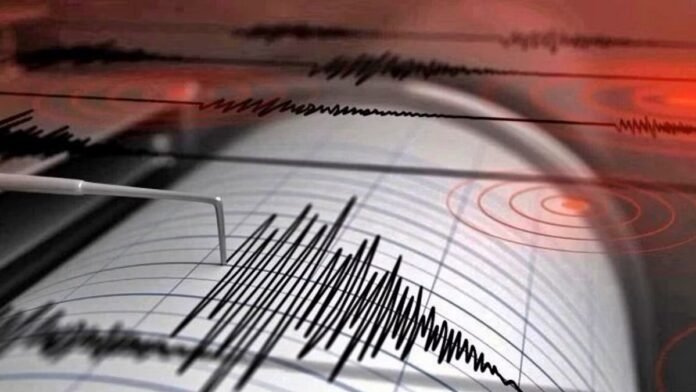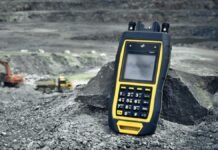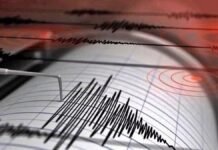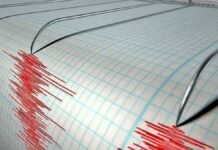
Key Points:
- A powerful 7.4 magnitude earthquake struck off Russia’s Kamchatka Peninsula on September 12, 2025, at 2:37 PM local time
- The earthquake occurred at a depth of 39.5 km, with its epicenter located 111.7 km east of Petropavlovsk-Kamchatsky, a city of 165,000 people
- Pacific Tsunami Warning Center issued tsunami warnings for Russian coastlines within 300 km of the epicenter, with waves up to 1 meter possible
- No immediate casualties or major damage reported, though residents fled buildings and shopping centers in panic
- This is the second major earthquake in the region following the devastating 8.8 magnitude quake in July 2025
Moscow: A powerful 7.4 magnitude earthquake struck off the eastern coast of Russia’s Kamchatka Peninsula on Saturday, September 12, 2025, at approximately 2:37 PM local time. The U.S. Geological Survey (USGS) initially reported the magnitude as 7.5 before revising it down to 7.4, while the German Research Centre for Geosciences (GFZ) recorded it as 7.1 magnitude.
The earthquake’s epicenter was located 111.7 kilometers east of Petropavlovsk-Kamchatsky, the regional capital with a population of approximately 165,000 people. The tremor originated at a depth of 39.5 kilometers according to USGS data, classifying it as a shallow earthquake capable of causing significant surface effects.
Governor Vladimir Solodov of the Kamchatka Krai region immediately issued a tsunami warning and advised residents near coastal areas to exercise extreme caution. Initial reports from Russian news agency RIA Novosti described residents fleeing from homes, workplaces, and shopping venues as the ground shook violently.
Tsunami Warning Systems Activated
The Pacific Tsunami Warning Center issued warnings for hazardous tsunami waves along Russian coastlines within a 300-kilometer radius of the earthquake’s epicenter. Officials warned that dangerous waves measuring 0.3 to 1 meter above normal tide levels were possible for areas within approximately 190 miles of the epicenter.
However, no tsunami threat was identified for Hawaii after initial assessment, with the Pacific Tsunami Warning Center confirming at 5:50 PM HST that based on all available data, Hawaiian islands faced no tsunami risk. Similarly, Japan reported no immediate tsunami alerts despite its proximity to the Kamchatka Peninsula.
No Immediate Casualties or Major Damage
Russian authorities reported no immediate casualties or widespread structural damage from the earthquake, though assessment teams were deployed to inspect buildings and infrastructure. The regional emergency ministry confirmed that operational teams of rescuers and firefighters were conducting thorough inspections of buildings in affected areas.
Residents of Petropavlovsk-Kamchatsky experienced considerable alarm during the tremor, with many evacuating buildings as a precautionary measure. The earthquake was felt with moderate intensity throughout the regional capital, though no reports of structural collapse or major infrastructure damage emerged in the immediate aftermath.
Aftershock Activity Monitoring
Seismologists detected several aftershocks following the main event, though these were of significantly lower magnitude and largely imperceptible to residents. The Kamchatka branch of Russia’s Unified Geophysical Service reported that most aftershocks were below the threshold of human perception.
Historical Context: Second Major Earthquake in Two Months
This earthquake represents the second major seismic event to strike the Kamchatka Peninsula in recent months, following the devastating 8.8 magnitude earthquake that occurred on July 29, 2025. The July earthquake was the strongest to hit the region since 1952 and triggered tsunami warnings across the entire Pacific Basin, affecting areas as distant as Hawaii, Japan, and French Polynesia.
The July 2025 earthquake caused significant damage and injuries in the isolated Russian region, with tsunami waves reaching up to 4 meters high across the Pacific. That event prompted evacuations of nearly two million people in Japan and triggered widespread tsunami alerts from California to Chile.
Ring of Fire Seismic Activity
The Kamchatka Peninsula lies along the Pacific Ring of Fire, one of the world’s most seismically active zones where approximately 90% of global earthquakes occur. The region is home to more than two dozen active volcanoes and experiences frequent seismic activity due to the complex interaction of tectonic plates.
Experts predict continued seismic activity in the region, with the potential for aftershocks reaching magnitudes up to 7.5 over the next month or more. The recent sequence of powerful earthquakes has raised concerns about the stability of the subduction zone interface along the Kuril-Kamchatka Trench.
Advanced Detection and Monitoring Systems
The earthquake provided a real-world test for NASA’s GUARDIAN tsunami detection system, which had deployed critical components just one day before the July earthquake. This experimental technology uses atmospheric pressure wave detection to identify tsunamis in real-time, offering potentially faster warning capabilities than traditional ocean buoy systems.
Multiple international seismological agencies monitored the event, including the German Research Centre for Geosciences, USGS, and regional Russian monitoring stations. The GFZ Helmholtz Centre for Geosciences recorded ground movement as far as Berlin, Germany, where seismic waves caused 6 millimeters of ground displacement.
Regional Preparedness and Ongoing Monitoring
Russian emergency services maintain heightened readiness in the Kamchatka region due to its location in one of the world’s most seismically active zones. The isolated peninsula’s geographic position makes rapid response challenging, requiring robust local emergency infrastructure and communication systems.
International cooperation in tsunami warning systems proved effective, with coordinated alerts issued by Pacific Tsunami Warning Centers across multiple nations. The rapid assessment and cancellation of tsunami threats for distant Pacific locations demonstrated the efficiency of modern early warning networks.
The ongoing seismic sequence in the Kamchatka region continues to be closely monitored by international geological agencies, with scientists tracking aftershock patterns and assessing the potential for additional major earthquakes in the coming weeks.




















































